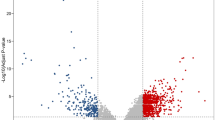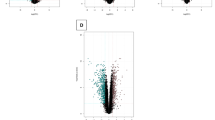Abstract
Cantharidin, a terpenoid produced by blister beetles, has been used in traditional Chinese medicine to treat various ailments and cancers. However, its biological activity, impact, and anticancer mechanisms remain unclear. The Cantharidin chemical gene connections were identified using various databases. The GSE21815 dataset was used to collect the gene expression information. Differential gene analysis and gene ontology analyses were performed. Gene set enrichment analysis was used to assess the activation of disease pathways. Weighted gene co-expression network analysis and differential analysis were used to identify illness-associated genes, examine differential genes, and discover therapeutic targets via protein–protein interactions. MCODE analysis of major subgroup networks was used to identify critical genes influenced by Cantharidin, examine variations in the expression of key clustered genes in colorectal cancer vs. control samples, and describe the subject operators. Single-cell GSE188711 dataset was preprocessed to investigate Cantharidin’s therapeutic targets and signaling pathways in colorectal cancer. Single-cell RNA sequencing was utilized to identify 22 cell clusters and marker genes for two different cell types in each cluster. The effects of different Cantharidin concentrations on colorectal cancer cells were studied in vitro. One hundred and ninety-seven Cantharidin-associated target genes and 480 critical genes implicated in the development of the illness were identified. Cantharidin significantly inhibited the proliferation and migration of HCT116 cells and promoted apoptosis at certain concentrations. Patients on current therapy develop inherent and acquired resistance. Our study suggests that Cantharidin may play an anti-CRC role by modulating immune function.










Similar content being viewed by others
Data availability
No datasets were generated or analysed during the current study.
References
Avuthu N, Guda C (2022) Meta-analysis of altered gut microbiota reveals microbial and metabolic biomarkers for colorectal cancer. Microbiol Spectr 10(4):e0001322
Branchi V et al (2019) Prognostic value of DLGAP5 in colorectal cancer. Int J Colorectal Dis 34(8):1455–1465
Ciombor KK, Wu C, Goldberg RM (2015) Recent therapeutic advances in the treatment of colorectal cancer. Annu Rev Med 66:83–95
Daina A, Michielin O, Zoete V (2019) SwissTargetPrediction: updated data and new features for efficient prediction of protein targets of small molecules. Nucleic Acids Res 47(W1):W357-w364
Davis AP et al (2021) Comparative Toxicogenomics Database (CTD): update 2021. Nucleic Acids Res 49(D1):D1138-d1143
Dennis G Jr et al (2003) DAVID: Database for Annotation, Visualization, and Integrated Discovery. Genome Biol 4(5):P3
Fakhr E et al (2021) LEF1 silencing sensitizes colorectal cancer cells to oxaliplatin, 5-FU, and irinotecan. Biomed Pharmacother 143:112091
Gilson MK et al (2016) BindingDB in 2015: A public database for medicinal chemistry, computational chemistry and systems pharmacology. Nucleic Acids Res 44(D1):D1045–D1053
Gu XD et al (2017) Cantharidin suppressed breast cancer MDA-MB-231 cell growth and migration by inhibiting MAPK signaling pathway. Braz J Med Biol Res 50(7):e5920
He T et al (2023) Mice kidney biometabolic process analysis after cantharidin exposure using widely-targeted metabolomics combined with network pharmacology. Food Chem Toxicol 171:113541
Hsia TC et al (2014) Cantharidin induces apoptosis of H460 human lung cancer cells through mitochondria-dependent pathways. Int J Oncol 45(1):245–254
Huang WW et al (2011) Cantharidin induces G2/M phase arrest and apoptosis in human colorectal cancer colo 205 cells through inhibition of CDK1 activity and caspase-dependent signaling pathways. Int J Oncol 38(4):1067–1073
Jacobsen A et al (2018) Aurora kinase A (AURKA) interaction with Wnt and Ras-MAPK signalling pathways in colorectal cancer. Sci Rep 8(1):7522
Kim S et al (2021) PubChem in 2021: new data content and improved web interfaces. Nucleic Acids Res 49(D1):D1388-d1395
Kishore C, Bhadra P (2021) Current advancements and future perspectives of immunotherapy in colorectal cancer research. Eur J Pharmacol 893:173819
Li S et al (2023) Exploring Cantharidin and its analogues as anticancer agents: a review. Curr Med Chem 30(18):2006–2019
Liu F et al (2020) Astragaloside IV Exerts Anti-tumor effect on murine colorectal cancer by re-educating tumor-associated macrophage. Arch Immunol Ther Exp (warsz) 68(6):33
Liu J et al (2023) AS-IV enhances the antitumor effects of propofol in NSCLC cells by inhibiting autophagy. Open Med (wars) 18(1):20230799
Lu J et al (2022) Mechanism of action of paclitaxel for treating glioblastoma based on single-cell RNA sequencing data and network pharmacology. Front Pharmacol 13:1076958
Modest DP, Pant S, Sartore-Bianchi A (2019) Treatment sequencing in metastatic colorectal cancer. Eur J Cancer 109:70–83
Naz F et al (2020) Anticancer attributes of cantharidin: involved molecular mechanisms and pathways. Molecules 25(14):3279
Nazim UM, Yin H, Park SY (2020) Downregulation of c-FLIP and upregulation of DR-5 by cantharidin sensitizes TRAIL-mediated apoptosis in prostate cancer cells via autophagy flux. Int J Mol Med 46(1):280–288
Palukuri MV, Marcotte EM (2021) Super.Complex: a supervised machine learning pipeline for molecular complex detection in protein-interaction networks. PLoS One 16(12):e0262056
Roda D et al (2020) Trifluridine/tipiracil in earlier lines of chemotherapy for advanced colorectal cancer. Ann Oncol 31(9):1097–1098
Schöpe PC et al (2023) Cantharidin and its analogue norcantharidin inhibit metastasis-inducing genes S100A4 and MACC1. Int J Mol Sci 24(2):1179
Shannon P et al (2003) Cytoscape: a software environment for integrated models of biomolecular interaction networks. Genome Res 13(11):2498–2504
Shi Y et al (2022) NCAPG facilitates colorectal cancer cell proliferation, migration, invasion and epithelial-mesenchymal transition by activating the Wnt/β-catenin signaling pathway. Cancer Cell Int 22(1):119
Soenjoyo KR et al (2020) Treatment of cutaneous viral warts in children: a review. Dermatol Ther 33(6):e14034
Sun S et al (2021) Tumor-targeted hyaluronic acid-mPEG modified nanostructured lipid carriers for cantharidin delivery: an in vivo and in vitro study. Fitoterapia 155:105033
Szklarczyk D et al (2023) The STRING database in 2023: protein-protein association networks and functional enrichment analyses for any sequenced genome of interest. Nucleic Acids Res 51(D1):D638-d646
Tan Z et al (2022) Integrin subunit alpha V is a potent prognostic biomarker associated with immune infiltration in lower-grade glioma. Front Neurol 13:964590
Tsai WL et al (2021) A new light on potential therapeutic targets for colorectal cancer treatment. Biomedicines 9(10):1438
The UniProt Consortium (2017) UniProt: the universal protein knowledgebase. Nucleic Acids Res 45(D1):D158–d169
Wang GS (1989) Medical uses of mylabris in ancient China and recent studies. J Ethnopharmacol 26(2):147–162
Wang T, Liu J, Xiao XQ (2015) Cantharidin inhibits angiogenesis by suppressing VEGF-induced JAK1/STAT3, ERK and AKT signaling pathways. Arch Pharm Res 38(2):282–289
Wang X et al (2021) TCM network pharmacology: a new trend towards combining computational, experimental and clinical approaches. Chin J Nat Med 19(1):1–11
Wang T et al (2022a) Network pharmacology of iridoid glycosides from Eucommia ulmoides Oliver against osteoporosis. Sci Rep 12(1):7430
Wang X et al (2022b) In situ targeting nanoparticles-hydrogel hybrid system for combined chemo-immunotherapy of glioma. J Control Release 345:786–797
Wang CH et al (2022) Inhibition of MZF1/c-MYC axis by Cantharidin impairs cell proliferation in glioblastoma. Int J Mol Sci 23(23):14727
Wen R et al (2023) Single-cell sequencing technology in colorectal cancer: a new technology to disclose the tumor heterogeneity and target precise treatment. Front Immunol 14:1175343
Xie YH, Chen YX, Fang JY (2020) Comprehensive review of targeted therapy for colorectal cancer. Signal Transduct Target Ther 5(1):22
Yi YC et al (2021) Dihydroartemisinin suppresses the tumorigenesis and cycle progression of colorectal cancer by targeting CDK1/CCNB1/PLK1 signaling. Front Oncol 11:768879
Zhang W et al (2014) Effect of cantharidins in chemotherapy for hepatoma: a retrospective cohort study. Am J Chin Med 42(3):561–567
Zhang Y et al (2017) Combination radiotherapy and cantharidin inhibits lung cancer growth through altering tumor infiltrating lymphocytes. Future Oncol 13(13):1173–1180
Zhang R et al (2019) Network pharmacology databases for traditional Chinese medicine: review and assessment. Front Pharmacol 10:123
Zhang Y et al (2020a) Single-cell transcriptome analysis reveals tumor immune microenvironment heterogenicity and granulocytes enrichment in colorectal cancer liver metastases. Cancer Lett 470:84–94
Zhang Q et al (2020b) KIF20A predicts poor survival of patients and promotes colorectal cancer tumor progression through the JAK/STAT3 signaling pathway. Dis Markers 2020:2032679
Zhang Z et al (2021) High expression of C1ORF112 predicts a poor outcome: a potential target for the treatment of low-grade gliomas. Front Genet 12:710944
Zhang J et al (2022) Glycosyltransferase-related long non-coding RNA signature predicts the prognosis of colon adenocarcinoma. Front Oncol 12:954226
Zheng K et al (2020) Cantharidin-loaded functional mesoporous titanium peroxide nanoparticles for non-small cell lung cancer targeted chemotherapy combined with high effective photodynamic therapy. Thorac Cancer 11(6):1476–1486
Zhou Z et al (2020a) Applications of network pharmacology in traditional Chinese medicine research. Evid Based Complement Alternat Med 2020:1646905
Zhou J et al (2020b) Norcantharidin: research advances in pharmaceutical activities and derivatives in recent years. Biomed Pharmacother 131:110755
Zhu M et al (2020) Cantharidin treatment inhibits hepatocellular carcinoma development by regulating the JAK2/STAT3 and PI3K/Akt pathways in an EphB4-dependent manner. Pharmacol Res 158:104868
Acknowledgements
We express our sincere gratitude to all colleagues and peers who provided assistance during the writing of this paper.
Funding
The study was supported by the Science and Technology Research Project of Education Department of Jiangxi Province (No. GJJ201210, GJJ200143), the Csco-Hengrui Cancer Research Fund (No. Y-HR2017-128), and the Science and Technology Project of Jiangxi Province Traditional Chinese Medicine Administration Bureau (No. 2019B085).
Author information
Authors and Affiliations
Contributions
Benchao Hou (H.BC.) conceived and designed the experiments.
Xiaomin Wang (W.XM.) performed the experiments.
Zhijian He (H.ZJ.) contributed reagents/materials/analysis tools and analyzed the data.
Haiyun Liu (L.HY.) provided critical revisions of the manuscript.
The authors declare that all data were generated in-house and that no paper mill was used.
Corresponding authors
Ethics declarations
Ethics approval
This study does not involve ethical issues.
Competing interests
The authors declare no competing interests.
Additional information
Publisher's Note
Springer Nature remains neutral with regard to jurisdictional claims in published maps and institutional affiliations.
Supplementary Information
Below is the link to the electronic supplementary material.
Rights and permissions
Springer Nature or its licensor (e.g. a society or other partner) holds exclusive rights to this article under a publishing agreement with the author(s) or other rightsholder(s); author self-archiving of the accepted manuscript version of this article is solely governed by the terms of such publishing agreement and applicable law.
About this article
Cite this article
Hou, B., Wang, X., He, Z. et al. Integrative approach using network pharmacology, bioinformatics, and experimental methods to explore the mechanism of cantharidin in treating colorectal cancer. Naunyn-Schmiedeberg's Arch Pharmacol (2024). https://doi.org/10.1007/s00210-024-03041-7
Received:
Accepted:
Published:
DOI: https://doi.org/10.1007/s00210-024-03041-7




